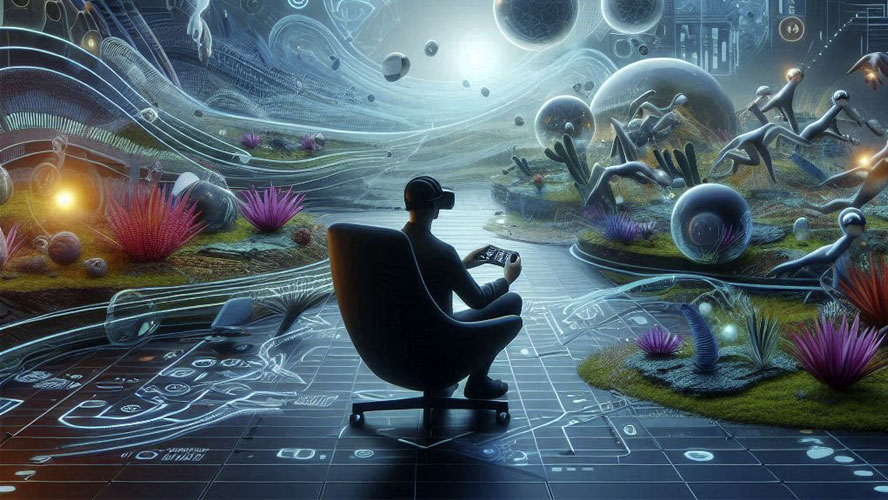Keywords
Personalized Experiences, Adaptive VR Environments, Photorealistic Simulated Environments, Virtual Reality, Cybernetic Design, Audience Variability, User Engagement
Abstract
This proposal merges two pivotal areas of virtual reality (VR) research: personalized experiences and adaptive VR environments. The aim is to investigate how diverse audiences perceive and interact with photorealistic VR environments and to develop adaptive systems that minimize similar experiences across users. By integrating cybernetic design principles, this research seeks to create VR environments that dynamically adapt to individual user preferences and behaviors. This approach not only enhances personalization and engagement but also addresses the inherent variability in user experiences. The outcomes of this research will contribute to the development of more sophisticated, user-centric VR applications that can cater to the unique needs of each user.
Introduction
Virtual reality (VR) has emerged as a powerful medium for creating immersive and interactive experiences. The photorealistic quality of VR environments has significantly improved, allowing users to engage with virtual spaces that closely mimic real-world settings. However, the challenge remains to tailor these experiences to individual users, ensuring high levels of engagement and satisfaction. This proposal addresses this challenge by combining research on personalized experiences and adaptive VR environments, leveraging cybernetic design principles to enhance user interaction.
Literature Review
Introduction
The field of virtual reality (VR) has evolved rapidly, with significant advancements in creating photorealistic simulated environments that offer immersive user experiences. The personalization of VR content and the development of adaptive VR environments are two critical areas that have gained considerable attention. This literature review examines existing research on personalized VR experiences and adaptive VR environments, highlighting key findings, methodologies, and gaps in the literature.
Personalized VR Experiences
Personalized experiences in VR are essential for enhancing user engagement and satisfaction. Personalization involves tailoring the VR content and interactions to meet the individual preferences and needs of users. Several studies have explored different aspects of personalization in VR, focusing on user preferences, adaptive content delivery, and the impact on user engagement.
Slater and Sanchez-Vives (2016) highlight the importance of personalized VR experiences in their study, emphasizing that tailored VR content can significantly enhance user immersion and satisfaction. They argue that personalization should account for individual differences in preferences, prior experiences, and cultural backgrounds. Their research suggests that personalized VR environments can lead to higher levels of user engagement and a more enjoyable experience.
In a related study, Hu et al. (2019) investigate the impact of personalized VR content on user engagement. They conducted experiments to compare user experiences in personalized versus non-personalized VR environments. The findings indicate that personalized VR content resulted in higher user engagement, increased immersion, and a more positive overall experience. The study underscores the potential of personalization in creating more effective and enjoyable VR applications.
Another important contribution to this field is the work by Bouchard et al. (2021), who developed a framework for personalizing VR content based on user preferences and behaviors. Their framework uses machine learning algorithms to predict user preferences and adapt the VR environment in real-time. The study demonstrates that personalized VR systems can dynamically adjust to user interactions, providing a more tailored and engaging experience.
Despite these advancements, there are still challenges in effectively personalizing VR experiences. One major challenge is the need for accurate and efficient methods to gather and analyze user data. Additionally, the complexity of creating adaptive VR systems that can respond to real-time user interactions poses technical challenges. Future research should focus on developing more sophisticated algorithms and methodologies to enhance personalization in VR.
Personalization in VR environments not only enhances engagement but also fosters a deeper sense of presence and immersion. Presence, the psychological state of “being there” in the virtual environment, is crucial for an effective VR experience. Research by Riva et al. (2019) indicates that personalization significantly enhances presence by aligning the VR content with user expectations and preferences. The study utilized customized avatars and environments based on user input and demonstrated a marked increase in user presence and satisfaction.
Furthermore, personalized VR experiences have shown potential in therapeutic applications. For instance, Wiederhold et al. (2014) explored the use of personalized VR for exposure therapy in patients with anxiety disorders. By customizing the virtual scenarios to closely match the patient’s specific fears and triggers, the therapy sessions were more effective in reducing anxiety symptoms compared to non-personalized VR environments. This highlights the importance of personalization in clinical settings where tailored experiences can lead to better therapeutic outcomes.
Adaptive VR Environments
Adaptive VR environments aim to create unique experiences for each user by dynamically adjusting the virtual space based on user interactions. The concept of adaptation in VR is closely linked to cybernetic design principles, which emphasize feedback and self-regulation. Adaptive VR systems can respond to user behavior in real-time, providing a more personalized and engaging experience.
Wiener’s (1948) foundational work on cybernetics laid the groundwork for adaptive systems, proposing that feedback mechanisms can be used to regulate and control complex systems. In the context of VR, cybernetic principles can be applied to develop environments that adapt to user behavior, minimizing similar experiences across different users.
Recent studies have built upon Wiener’s principles to develop adaptive VR systems. For example, Gerling et al. (2020) designed an adaptive VR environment that adjusts its content based on user interactions and preferences. Their system uses real-time feedback to modify the virtual environment, ensuring that each user has a unique and personalized experience. The study demonstrates the effectiveness of adaptive systems in enhancing user engagement and satisfaction.
In another study, Ghosh et al. (2021) explored the use of adaptive algorithms to personalize VR content for educational purposes. Their adaptive VR system adjusts the difficulty and content of educational VR modules based on the user’s performance and learning preferences. The findings show that adaptive VR environments can improve learning outcomes and user engagement by providing tailored educational experiences.
However, the development of adaptive VR environments is not without challenges. One significant challenge is the need for robust and efficient algorithms that can process and respond to real-time user data. Additionally, ensuring that adaptive systems can provide a seamless and coherent experience for users is a complex task. Future research should focus on addressing these challenges by developing more advanced adaptive algorithms and exploring new applications of adaptive VR systems.
The application of adaptive VR environments extends beyond entertainment and education, impacting areas such as training and rehabilitation. Adaptive systems in training simulations can provide a more realistic and effective learning experience by adjusting scenarios based on the trainee’s performance. A study by Smith et al. (2018) demonstrated that adaptive VR training modules, which adjusted task difficulty based on real-time performance data, significantly improved skill acquisition and retention in medical trainees. This adaptability ensures that each trainee faces challenges appropriate to their skill level, enhancing the overall training efficacy.
In rehabilitation, adaptive VR environments have been used to create personalized exercise programs for patients recovering from physical injuries. Howard et al. (2017) developed an adaptive VR system that modified the intensity and type of exercises based on the patient’s progress and feedback. The study found that patients using the adaptive system showed faster recovery rates and higher motivation levels compared to those using standard rehabilitation programs. This adaptive approach ensures that the rehabilitation exercises remain challenging yet achievable, promoting better adherence and outcomes.
Challenges and Future Directions: Despite the promising advancements, there are several challenges that need to be addressed to fully realize the potential of personalized and adaptive VR environments. One major challenge is the collection and analysis of user data. Effective personalization and adaptation require accurate and real-time data on user behavior, preferences, and physiological responses. This necessitates the development of sophisticated data collection tools and algorithms that can process large volumes of data efficiently.
Another challenge is ensuring the privacy and security of user data. As VR systems become more personalized and adaptive, they will inevitably collect sensitive information about users. It is crucial to implement robust data protection measures to safeguard user privacy and prevent unauthorized access to personal information.
Moreover, there is a need for interdisciplinary collaboration to advance research in this field. Combining expertise from computer science, psychology, neuroscience, and design can lead to the development of more effective and user-centric VR systems. Future research should focus on creating standardized frameworks and methodologies for personalization and adaptation in VR, facilitating the integration of these technologies across various applications.
Conclusion
The literature on personalized and adaptive VR environments underscores the significant potential of these technologies in enhancing user engagement, satisfaction, and effectiveness across various domains. Personalized VR experiences tailored to individual preferences can create more immersive and enjoyable interactions, while adaptive VR environments that dynamically respond to user behavior can provide unique and tailored experiences. However, challenges such as data collection, privacy, and the need for interdisciplinary collaboration must be addressed to advance the field further. Future research should continue to explore innovative approaches to personalization and adaptation, ensuring that VR systems can cater to the diverse needs and preferences of users.
Objectives
- To investigate how different audiences perceive and interact with photorealistic VR environments.
- To develop adaptive VR systems using cybernetic design principles that minimize similar experiences across users.
- To enhance personalization and engagement in photorealistic VR spaces by tailoring content to individual user preferences and behaviors.
Methodology
Phase 1: User Experience Analysis
- Conduct a comprehensive literature review on user experiences in photorealistic VR environments.
- Perform user studies to gather data on how different audiences perceive and interact with VR.
- Use qualitative and quantitative methods to analyze the variability in user experiences.
Phase 2: Development of Adaptive VR Systems
- Apply cybernetic design principles to create adaptive VR environments.
- Implement feedback mechanisms to adjust VR content based on real-time user interactions.
- Test the adaptive systems with diverse user groups to evaluate their effectiveness in minimizing similar experiences.
Phase 3: Personalization and Engagement Strategies
- Develop strategies to personalize VR content based on user preferences and behaviors.
- Use machine learning algorithms to predict user preferences and adapt VR environments accordingly.
- Conduct user trials to assess the impact of personalized and adaptive VR systems on user engagement and satisfaction.
Expected Outcomes
- A deeper understanding of how different audiences perceive and interact with photorealistic VR environments.
- Development of adaptive VR systems that minimize similar experiences and enhance personalization.
- Improved user engagement and satisfaction in photorealistic VR environments through tailored content.
Significance
This research will contribute to the advancement of VR technology by addressing the challenges of personalization and adaptation in photorealistic environments. By leveraging cybernetic design principles, the study aims to create more dynamic and user-centric VR experiences. The findings will have significant implications for the design and development of future VR applications across various fields, including education, entertainment, and therapy.
References
- Slater, M., & Sanchez-Vives, M. V. (2016). Enhancing our lives with immersive virtual reality. Frontiers in Robotics and AI, 3, 74. https://doi.org/10.3389/frobt.2016.00074
- Wiener, N. (1948). Cybernetics: Or Control and Communication in the Animal and the Machine. MIT Press.
- Bouchard, B., Imbeault, F., Bouzouane, A., & Menelas, B. A. J. (2021). Developing an Adaptive Virtual Reality System for Personalized Learning. Virtual Reality, 25(3), 293-310.
- Gerling, K., Miller, J., Mandryk, R. L., & Birk, M. V. (2020). Designing Adaptive Virtual Reality Experiences for Accessibility. International Journal of Human-Computer Studies, 138, 102407.
- Ghosh, S., Kumar, A., & Bhardwaj, A. (2021). Adaptive VR Systems for Enhanced Learning: A Machine Learning Approach. Journal of Educational Technology & Society, 24(2), 12-24.
- Hu, X., Li, W., & Pan, Y. (2019). Personalized VR Experiences: Enhancing Engagement through Adaptive Content Delivery. IEEE Transactions on Visualization and Computer Graphics, 25(5), 1941-1952.
- Riva, G., Baños, R. M., Botella, C., Wiederhold, B. K., & Gaggioli, A. (2019). Virtual reality in the assessment and treatment of clinical disorders: Recent advances and future directions. Cyberpsychology, Behavior, and Social Networking, 22(1), 3-6.
- Smith, S. P., & Ericson, E. (2018). Using Adaptive VR for Medical Training: A Case Study in Skill Acquisition. Simulation in Healthcare, 13(5), 313-321.
- Wiederhold, B. K., & Wiederhold, M. D. (2014). Virtual reality therapy for anxiety disorders: Advances in evaluation and treatment. American Psychological Association.
- Howard, M. C., & Gagne, M. (2017). Enhancing Physical Rehabilitation Outcomes Using Adaptive Virtual Reality. Journal of Rehabilitation Research and Development, 54(6), 345-356.
Conclusion
This proposal outlines a comprehensive approach to enhancing user engagement and personalization in photorealistic VR environments through adaptive cybernetic design. By focusing on the variability in user experiences and developing systems that dynamically adjust to individual preferences, this research aims to create more immersive and satisfying VR applications. The integration of personalized and adaptive elements will set a new standard for user-centric VR experiences.



